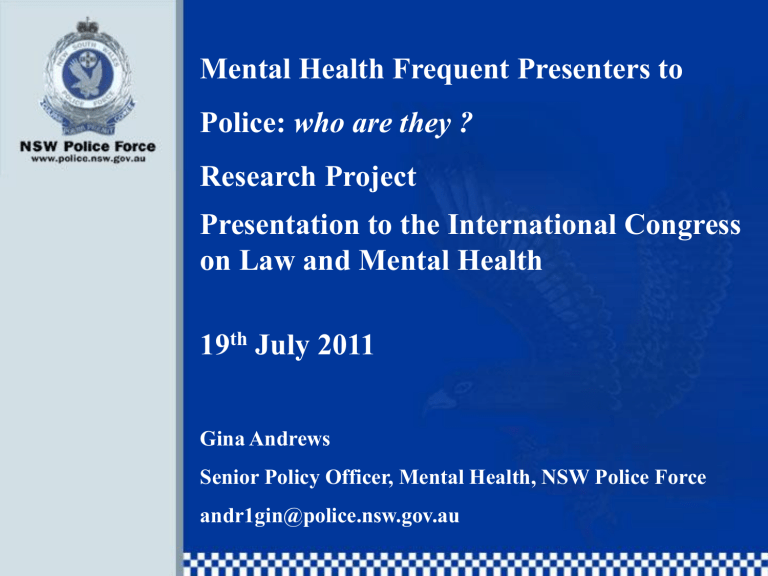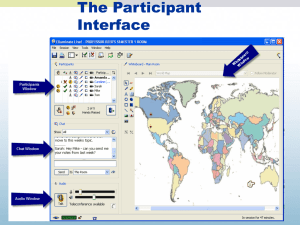Mental Health Frequent Presenters Project

Mental Health Frequent Presenters to
Police: who are they ?
Research Project
Presentation to the International Congress on Law and Mental Health
19 th July 2011
Gina Andrews
Senior Policy Officer, Mental Health, NSW Police Force andr1gin@police.nsw.gov.au
Mental Health Frequent Presenters to Police
Presentation outline:
1.
Setting the scene: a case study
2.
Goals of the research project
3.
Project history a) Research stages b) Research method c) Research findings
4.
Research next steps and program options
5.
Conclusion
Scene Set: Mental Health Frequent Presenters Case Study
• ‘Naomi’: female aged 18
• 35 apprehensions Mental
Health Act in past year
• Total of 45 Police events
• Victim of sexual assault/incest
• History of aggressive behaviour & self harm
• Escalating behaviour
• Therapeutic response in place but inadequate
Research Goals: Mental Health Frequent Presenters
Goals:
1. To describe the characteristics of persons who have frequent emergency mental health contacts with Police, Ambulance and Health.
2. Developing appropriate care co-ordination model for this group.
3. Trial a care co-ordination model.
Project History: Mental Health Frequent Presenters
• 2007: One of 8 Mental
Health projects developed
• Mid 2008 – 2009:
Develop business case
• 2010: research contract awarded
• Jan 2011: Stage 1,
Phase 1 Report completed
Research Method: Mental Health Frequent Presenters
• Individual agency datasets: persons presenting 3 or more times under the Mental Health Act in a year.
• 2005 as index year.
• NSW Statewide data identification used (except emergency departments).
• Frequent (i.e. individual presenting three or more times in given year under Mental Health Act) vs very high (i.e. top 10% of MHFPs at each agency).
Research Stages: Mental Health Frequent Presenters
Stage 1: Examination of data on Mental Health
Frequent Presenters
Within agencies
Stage 2: Identify
Develop and implement service model/s
Phase 1 (completed):
Within agencies
Research Findings: Mental Health Frequent Presenters
NSWPF
>3 presentations
Female %
Aboriginal %
Avg Age (yrs)
1010 individuals
44%
14%
34
Very High Frequency (top 10% of MHFP)
90th percentile contact cutoff Min nu events = 7
Avg contacts top
10% FP
10
Research Findings NSWP: Mental Health Frequent Presenters
• Over 13, 500 with at least one mental health event.
Total of 18, 672 mental health events in 2005.
• 7% (1010 persons) of overall population under the
MH Act had at least three or more contacts per year therefore qualifying as Frequent Presenters.
• 7% of persons apprehended by Police under the
Mental Health Act were responsible for 23% of all MH
Act events.
• 33 people (3.3%) had 10 or more events per annum.
Research Findings NSWP: Mental Health Frequent Presenters
• 90% of MHFPs had contact other than MH Act that year:
– 82% as a “person of interest” (POI).
– 63% as victims of crime.
– The Mental Health Act contacts accounted for only around 25-30% of total contacts for frequent presenters.
• Frequent presentation was not stable over time – >50% did not continue pattern of MHFP in subsequent years
Research Next Steps: Mental Health Frequent Presenters
• Stage 1 : “Phase 2” (linked data):
– Awaiting ethics approval
– Time and resources required for data analysis & report 2
– Jostling for governance and hosting project.
• Stage 2 : Service model development:
– Clarification of scope (very high frequent presenters or frequent presenters)
– Case management approach (medical & psycho social)
– Modeling of costs, business case development.
Research Next Steps: Mental Health Frequent Presenters
Possible program response ?
TARGET GROUP TYPE OF STRATEGY
Very High FP
(top 10% of FP)
Approx 50 persons
New / targeted / specialised services
MHFP =
3 contacts with Police
= 1010 persons
Capacity-building across many services
Conclusion: Mental Health Frequent Presenters
• MHFP to Police are a small group who use a disproportionate amount of Police resources
• MHFP pattern of interaction with Police is diverse and includes: Mental Health Act, Person of Interest, and victim.
• MHFPs are likely to interact heavily with the wider criminal justice system and emergency services.
• Evidence base in favour of intensive case management of
MHFP demonstrates that such an intervention results in a reduction of MHFPs interaction with emergency services.







